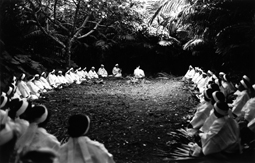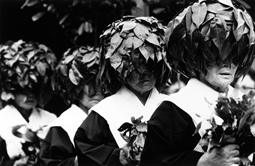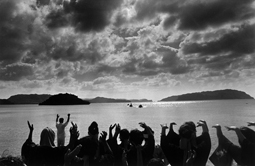 |
|
Here and There introduces art, artists, galleries and museums around Japan that non-Japanese readers and first-time visitors may find of particular interest. The writer claims no art expertise, just a subjective viewpoint acquired over many years' residence in Japan.
|
|
 |
|
|
 |
 |
Shamanesses in Black and White: Yasuo Higa at the Izu Photo Museum
Alan Gleason |
 |
 |
|
 |
| Kudaka Island, Fubawaku, 1975. Photograph by Yasuo Higa |
|
Kudaka Island, Fubo Utaki, Fubawaku, 1975. Photograph by Yasuo Higa |
For the glimpses they offer of a living legacy of Japan's primeval past, Yasuo Higa's monochrome photographs of Okinawan women performing ancient shamanistic rituals in the 1970s and 80s are a revelation. Of course, these are not really Japanese rituals; they belong to an era when the Ryukyu Islands were their own sovereign kingdom. Indeed, many of the outlying islands where these ceremonies are best preserved were reluctant to submit even to the rule of the Ryukyu court on the main island of Okinawa. The culture these rituals represent was indigenous, isolated, and very much at one with its environment. Performed exclusively by village women at holy sites known as utaki, from which men were banned, the ceremonies sought the blessings of the gods for good catches, harvests, and health. These "maternal deities" (as Higa refers to them) were the souls of ancestors living in a place of rebirth known as nirai kanai (or nira hara in some dialects) far out at sea.
Higa (1938-2000) was a former police photographer in postwar Okinawa while the islands were still under U.S. occupation (they did not revert to Japanese rule until 1972). A visit to the island of Miyako, where he saw shamanesses going into trances to conduct religious ceremonies, changed his life. From then on he devoted himself to recording the traditional rituals and routines of these island communities -- already threatened in his day with extinction by the encroachment of modern ways.
 |
|
 |
| Miyako Island, Karimata, Uyan, 1989. Photograph by Yasuo Higa |
|
Iriomote Island, Sonai, Shitsu, 1974. Photograph by Yasuo Higa |
Higa's photos fill several volumes, chronicling life on islands across the entire Ryukyu archipelago. But he was particularly enamored of Kudaka-jima, a small island just off the coast of Okinawa proper. Kudaka was the designated sacred island of the Ryukyu court, and the entire population was historically involved in some way or other with the performance of gods-appeasing ceremonies. Higa made some 100 trips there and earned the trust of the islanders to the extent that he was allowed to photograph rituals that had previously been off-limits to men. Today, Kudaka remains one of the few spots where these traditions are still carried out. Yet there has been attrition of late: one of the most important ceremonies -- normally conducted every 12 years -- has not taken place since 1978, due to the death of the last hereditary shamaness on the island.
A stunning exhibition of over 160 of Higa's sensitive and dramatic portrayals of these rituals, on Kudaka and elsewhere, is on display through May 31 at a venue that, somewhat ironically, embodies contemporary Japan at its least traditional. Opened in 2009, the Izu Photo Museum is part of a sprawling, very trendy arts-and-eats complex in the southeastern foothills of Mt. Fuji in Shizuoka Prefecture. Developed by a local real estate company, Clematis no Oka (Clematis Hill) encompasses not only the photo museum, but an art museum devoted to the work of French painter Bernard Buffet, a garden full of monumental works by the Italian sculptor Giuliano Vangi, and a literary museum dedicated to bestselling author and local favorite son Yasushi Inoue. The grounds also boast a trellis garden of clematis flowers and several restaurants offering Japanese or Italian cuisine. Like most of the art on display at Clematis no Oka, the overall ambience is unapologetically Western and contemporary. Nothing wrong with that, but upon emerging from Higa's universe into the shiny glass-and-concrete world outside, one experiences a sort of cultural vertigo.
Interestingly, the building that houses the Izu Photo Museum itself underwent an ambitious transformation in what might be termed the opposite direction before reopening in 2009 (previously it served as a museum of Nihonga art). The owners commissioned artist Hiroshi Sugimoto to re-design the interior, which he did with gusto. Notable among his additions are a number of large stone sculptures or installations that evoke ancient Japanese tombs. In their way, these monoliths provide a resonant backdrop to Higa's photographs. On the other hand, as the curator of the Higa show pointed out with a smile, the third- to seventh-century kofun tumuli that inspired Sugimoto were grandiose symbols of the power of the Yamato clan as it extended its hegemony across Japan, ultimately giving birth to the regime that today has, both by intention and neglect, hastened the demise of the traditional culture of the Ryukyu Islands.
 |
|
 |
Entrance to the Izu Photo Museum, with landscape garden designed by Hiroshi Sugimoto in the background. Photo by Alan Gleason
|
|
The Vangi Sculpture Garden, next to the Izu Photo Museum at Clematis no Oka. Photo by Alan Gleason
All images by permission of the Izu Photo Museum |
|
|
 |
Maternal Deities: Yasuo Higa Exhibition |
 |
23 January - 31 May 2011 |
 |
Izu Photo Museum |
 |
347-1 Higashino Clematis no Oka, Nagaizumi-cho, Shizuoka Prefecture
Phone: 055-989-8780
Hours: 10:00-18:00 (last admission 30 minutes before closing); closed Wednesday or the following day when Wednesday is a holiday (Note: check museum website for earlier closing times after August)
Transportation: Hourly shuttle bus (25-minute ride) from stop no. 3 at north entrance of JR Mishima station, one hour southwest of Tokyo on the Tokaido Shinkansen Line |
 |
|
 |
|
|
 |
 |
Alan Gleason
Alan Gleason is a translator, editor and writer based in Tokyo, where he has lived for 25 years. In addition to writing about the Japanese art scene he has edited and translated works on Japanese theater (from kabuki to the avant-garde) and music (both traditional and contemporary). |
|
|
|
 |
|